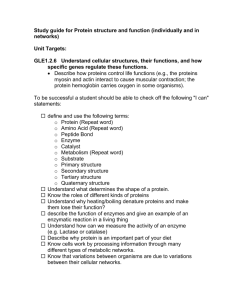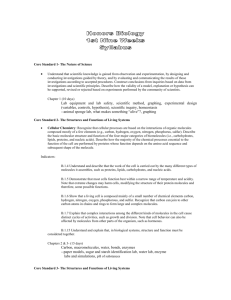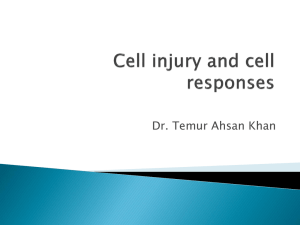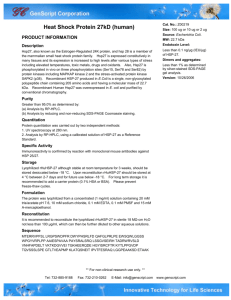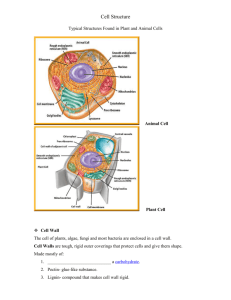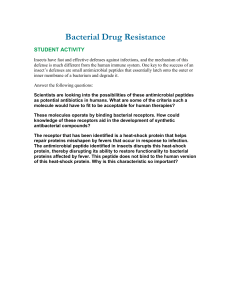Heat shock proteins as sensors of nonthermal effects?
advertisement
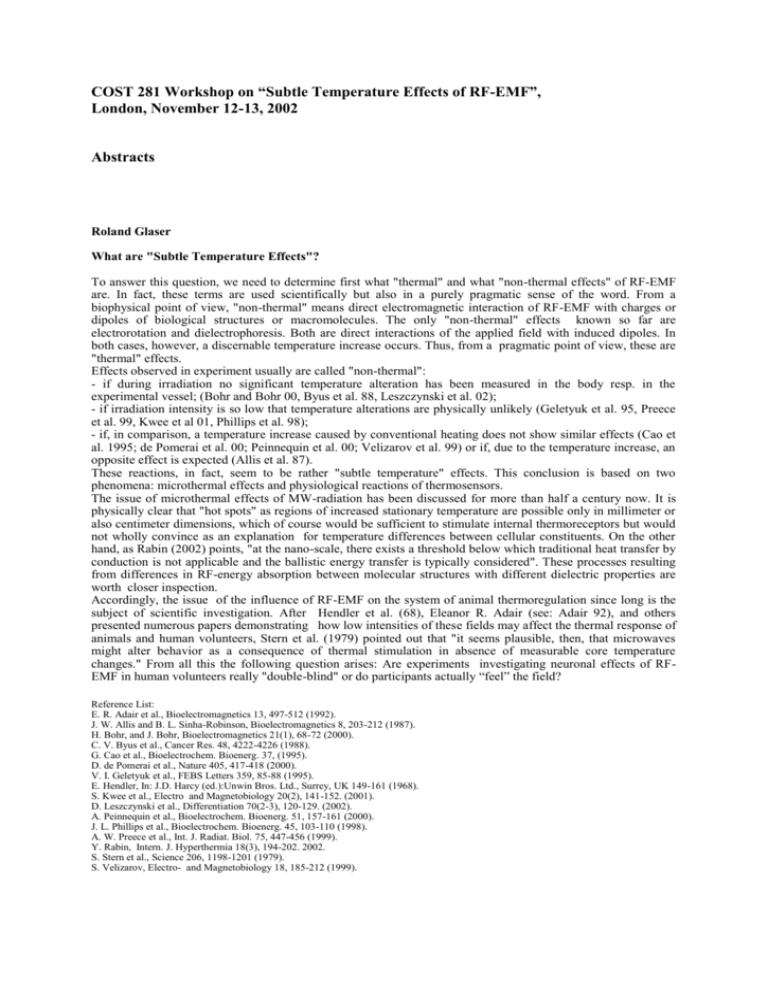
COST 281 Workshop on “Subtle Temperature Effects of RF-EMF”, London, November 12-13, 2002 Abstracts Roland Glaser What are "Subtle Temperature Effects"? To answer this question, we need to determine first what "thermal" and what "non-thermal effects" of RF-EMF are. In fact, these terms are used scientifically but also in a purely pragmatic sense of the word. From a biophysical point of view, "non-thermal" means direct electromagnetic interaction of RF-EMF with charges or dipoles of biological structures or macromolecules. The only "non-thermal" effects known so far are electrorotation and dielectrophoresis. Both are direct interactions of the applied field with induced dipoles. In both cases, however, a discernable temperature increase occurs. Thus, from a pragmatic point of view, these are "thermal" effects. Effects observed in experiment usually are called "non-thermal": - if during irradiation no significant temperature alteration has been measured in the body resp. in the experimental vessel; (Bohr and Bohr 00, Byus et al. 88, Leszczynski et al. 02); - if irradiation intensity is so low that temperature alterations are physically unlikely (Geletyuk et al. 95, Preece et al. 99, Kwee et al 01, Phillips et al. 98); - if, in comparison, a temperature increase caused by conventional heating does not show similar effects (Cao et al. 1995; de Pomerai et al. 00; Peinnequin et al. 00; Velizarov et al. 99) or if, due to the temperature increase, an opposite effect is expected (Allis et al. 87). These reactions, in fact, seem to be rather "subtle temperature" effects. This conclusion is based on two phenomena: microthermal effects and physiological reactions of thermosensors. The issue of microthermal effects of MW-radiation has been discussed for more than half a century now. It is physically clear that "hot spots" as regions of increased stationary temperature are possible only in millimeter or also centimeter dimensions, which of course would be sufficient to stimulate internal thermoreceptors but would not wholly convince as an explanation for temperature differences between cellular constituents. On the other hand, as Rabin (2002) points, "at the nano-scale, there exists a threshold below which traditional heat transfer by conduction is not applicable and the ballistic energy transfer is typically considered". These processes resulting from differences in RF-energy absorption between molecular structures with different dielectric properties are worth closer inspection. Accordingly, the issue of the influence of RF-EMF on the system of animal thermoregulation since long is the subject of scientific investigation. After Hendler et al. (68), Eleanor R. Adair (see: Adair 92), and others presented numerous papers demonstrating how low intensities of these fields may affect the thermal response of animals and human volunteers, Stern et al. (1979) pointed out that "it seems plausible, then, that microwaves might alter behavior as a consequence of thermal stimulation in absence of measurable core temperature changes." From all this the following question arises: Are experiments investigating neuronal effects of RFEMF in human volunteers really "double-blind" or do participants actually “feel” the field? Reference List: E. R. Adair et al., Bioelectromagnetics 13, 497-512 (1992). J. W. Allis and B. L. Sinha-Robinson, Bioelectromagnetics 8, 203-212 (1987). H. Bohr, and J. Bohr, Bioelectromagnetics 21(1), 68-72 (2000). C. V. Byus et al., Cancer Res. 48, 4222-4226 (1988). G. Cao et al., Bioelectrochem. Bioenerg. 37, (1995). D. de Pomerai et al., Nature 405, 417-418 (2000). V. I. Geletyuk et al., FEBS Letters 359, 85-88 (1995). E. Hendler, In: J.D. Harcy (ed.):Unwin Bros. Ltd., Surrey, UK 149-161 (1968). S. Kwee et al., Electro and Magnetobiology 20(2), 141-152. (2001). D. Leszczynski et al., Differentiation 70(2-3), 120-129. (2002). A. Peinnequin et al., Bioelectrochem. Bioenerg. 51, 157-161 (2000). J. L. Phillips et al., Bioelectrochem. Bioenerg. 45, 103-110 (1998). A. W. Preece et al., Int. J. Radiat. Biol. 75, 447-456 (1999). Y. Rabin, Intern. J. Hyperthermia 18(3), 194-202. 2002. S. Stern et al., Science 206, 1198-1201 (1979). S. Velizarov, Electro- and Magnetobiology 18, 185-212 (1999). Mays Swicord Literature Survey on Subtle Temperature Effects No abstract. Slides of presentation are available at www.cost281.org/documents Carmela Marino Low exposure can generate the level and duration of the overheating in the biological samples such as to induce the significant biological effects? Carmela Marino and Giorgio A. Lovisolo; ENEA, C.R. Casaccia, Rome, Italy From the literature data since 1977 up to now, the biological effects of heat are shown as “an acceleration of biochemical reactions according to the Arrhenius law”, indeed the thermal dose response curves of several cell lines are a modification of the Arrhenius plot. The second questions: “does a temperature increase; ……or is it rather a problem of thermo-reception followed by a complicated set of biological control mechanisms?” The question of ”hot spots” is related to in vitro and in vivo modalities, but it is true that, depending on hot spot size and the effectiveness of the heat removal, there may be no measurable increase in local or whole system temperatures. Thermoreceptor should be activated in a whole body exposure, but no at the actually exposure SAR level used in experimental activities. Normally the SAR distribution in the biological samples exposed at the radiofrequencies is not homogeneous. It is well known that the SAR variation level depends on the size, shape and biological nature of the exposed sample, and on the characteristics of the incident electromagnetic radiation. Generally, due to the dielectric differences among tissues and to the complex shape, the variation is greater in vivo (rats, mice,..,etc) [1,2], than in vitro but also in the last case the significant SAR gradients (a few dB) are evidenced even with the simple geometric shapes (Petri dishes, flasks, tubes) [2,3]. During the characterization procedures for the exposure systems the high SAR gradients are calculated [5,6] but we were not able to test the phenomena in experimental way. Nevertheless the hot spots can be induced even without any alteration of the body temperature in the total or partial body exposure. Hyperthermia, the procedure of raising the temperature of tumour-loaded tissue to 40-43 degrees C, refers, in oncology, to the treatment of malignant diseases by administering heat in various ways, and it is applied as an adjunctive therapy with various established cancer treatments such as radiotherapy and chemotherapy. The potential to control power distributions in vivo has been significantly improved lately by the development of planning systems and other modeling tools [7]. It is well established that sustained temperature above 42°C will cause necrosis of living cells as direct cytotoxic effect of heat, and/or the synergism of heat in conjunction with radiation and drugs: it is thought that hyperthermia (42-46°C) alters the function of many structural and enzymatic proteins within cells, which in turn alters cell growth and differentiation, can induce apoptosis and modulation of drug resistance. Moreover the cellular effects of hyperthermia including the expression of heat-shock proteins (HSP), the induction and regulation of apoptosis, signal transduction.[8 Normal human diploid cells and various human tumour cells were heat shocked at 43 degrees C for 2h and allowed to recover at 37 degrees C. It was found, for example, that heat shock treatment transiently disrupted the immunostaining of centrosomes, and no centrosome staining was detected in either normal or tumour cells 24h after heat shock [9] Available data indicate that heat shock proteins act as chaperones under non-stress conditions by assisting in: (1) the folding of newly synthesized proteins, (2) the intracellular translocation of proteins, and (3) the function of other proteins. As we gain additional information concerning cellular physiology, we may find that heat shock proteins play a key role in many additional cellular functions [10]. Therefore the induction of HSP also described by de Pomerai et al [11], investigating the expression of heat shock proteins in the Nematode Caenorhabditis elegans, could involve non-thermal mechanism, for example the disruption of weak bonds or the interference with cell-signaling pathways. Heat-induced cell death and apoptosis were studied with respect to intracellular ATP. Apoptosis is an important form of physiologic cell death displayed by an enormous variety of tissues under divergent conditions. The recent attention toward apoptosis in virtually all aspects of modern biology indicates that rapid and accurate differentiation between apoptosis and necrotic death is of considerable interest. Apoptosis is distinguishable from necrosis on the basis of several criteria. Studies on the relationship between hyperthermic cell-killing at 44 degrees C and cellular ATP levels in four cell lines grown as monolayers and six cell lines grown in suspension showed good correlations between cellular ATP levels and the sensitivity to heat. D(0) values (the dose required to reduce survival in the linear portion of the response by 63%) linearly increased with an increase in cellular ATP levels. Heat-induced apoptosis in L5178Y cells was observed following treatment at 42°C for 70 min, 44°C for 20 min or 47°C for 3 min, which corresponded to surviving fractions (SF) of 25.0%, 0.6% and 0.8% respectively, but not at 47°C for 20 min (SF 0.1%), indicating that mild heat shock induced apoptosis. These results suggest that the inhibition of ATP synthesis is closely associated with the enhancement of sensitivity to heat and that ATP is required for chromatin condensation during apoptosis [12]. These considerations on hyperthermia could help to establish the difference between the biological thermal effects due to the time and the degree of the heat exposure and the energy and the degree of low values of EMRF fields. For these reasons even in experiments where the body temperature alteration are not registered we should investigate deeply the level and the duration of the local increasing of temperature for comparing these parameters with the knowledge already well confirmed on the relationship between overheating and biological effects. References 1. C.K. Chou, K.W. Chan, J.A. McDougall, and A.W. Guy. Development of a Rat Head Exposure System for Simulating Human Exposure to RF Fields From Handheld Wireless Telephones. Bioelectromagnetics 20:75–92, 1999. 2. P. Gaj_sek, J.M. Ziriax, W.D. Hurt, T.J.Walters, and P.A. Mason Predicted SAR in Sprague-Dawley Rat as a Function of PermittivityValues. Bioelectromagnetics 22:384-400 (2001). 3. A.W. Guy, C.K. Chou, and J.A. McDougall. A Quarter Century of In Vitro Research: A New Look at Exposure Methods. Bioelectromagnetics 20:21–39, 1999. 4. L. Laval, Ph. Leveque, and B. Jecko. A New InVitro Exposure Device for the Mobile Frequency of 900 MHz. Bioelectromagnetics 21:255-263, 2000. 5. C. Marino, G. Cristalli, M.F. Durante, P. Galloni, P. Pasqualetti, M. Piscitelli, G.A. Lovisolo “Effects of microwaves (900 MHz) on the cochlear receptor: exposure system and preliminary results“, Radiat Environ Biophys 39: 131-136, 2000. 6. G. D'Inzeo, F. Apollonio, M. Liberti, L. Ardoino, G.A. Lovisolo. Design and realization of an in vitro exposure system based on a resonant structure at 1.8 and 2.2 GHz. EMC, Sorrento, 2002. 7. Wust P, Hildebrandt B, Sreenivasa G, Rau B, Gellermann J, Riess H, Felix R, Hyperthermia in combined treatment of cancer, Schlag PM: Lancet Oncol 3(8):487-97, 2002. 8. Hildebrandt B, Wust P, Ahlers O, Dieing A, Sreenivasa G, Kerner T, Felix R, Riess H, The cellular and molecular basis of hyperthermia, Crit Rev Oncol Hematol; 43(1): 33-56, 2002. 9. Nakahata K, Miyakoda M, Suzuki K, Kodama S, Watanabe M, Heat shock induces centrosomal dysfunction, and causes non-apoptotic mitotic catastrophe in human tumour cells, Int J Hyperthermia 18: 332-43, 2002. 10. Mirkes PE., Molecular/cellular biology of the heat stress response and its role in agent-induced teratogenesis, Mutat Res 12; 396(1-2):163-73, 1997. 11. de Pomerai et al. Nature 25, 405, 417-418, 2000. 12. Miyazaki N, Kurihara K, Nakano H, Shinohara K, Role of ATP in the sensitivity to heat and the induction of apoptosis in mammalian cells, Int J Hyperthermia 18: 316-31, 2002. René de Seze Temporal Skin Warming During Exposure To Cellular Telephones G. Pina (1), P. Malzac (2), R. de Sèze (1) (1) Laboratoire de Biophysique Médicale, Nîmes, France (2) CHU Montpellier, France Radiocellular phone use causes heat perception. Part of the radiofrequency electromagnetic field is absorbed in the user’s head (40 - 50 %) and the absorption is highest in the skin ([1] – [2]). Calculations of changes in brain temperature when the phone is in contact with the ear shows : i) for a radiated power of 600mW [1] a maximum rise at the skin of 0.22 - 0.43 °C and temperature increase in the brain of 0.09 - 0.16 °C (SAR induced in the head : SAR 10g = 1.0-2.0 W/kg - SAR 1g : 2 - 3.5 W/kg) and ii) for an average emitted power of 250 mW [2] a maximum temperature rise at the skin of 0.263 °C and in the brain of 0.005 °C (SAR 10g = 0.93W/kg SAR 1g : 1.53 W/kg). We measured the temperature increase of the temporal skin due to exposure to GSM 900 (900 MHz radiated power 250mW) and GSM 1800 (1800 MHz - radiated power 125 mW), using a Luxtron 790 F optic fibers thermometer. The sensors were placed face to face in a very precise position one on the phone the other one on the volunteer’s skin. The phone was held by the hand of the volunteer in a normal position of use - this putting the two temperature probes in a very close position. Temperature was recorded until steady state is reached. The steady state temperatures with the battery on but without emission (reception mode for 30 min allowing for temperature equilibration) were of 36.9 +/- 0.3 °C for GSM 900 and 37.4 +/- 0.4 °C for GSM 1800. Warming of the phone alone between a stabilized reception mode and a stabilized emission mode, measured at a room temperature of 18 °C, was found to be 4.4 °C for GSM 900 and 2.8 °C for GSM 1800. The skin temperature difference between reception mode and emission mode when the phone was emitting at full power (250 mW for GSM 900 and 125 mW for GSM 1800) was 0.93 +/- 0.24 °C for GSM 900 and 0.66 +/- 0.18 °C for GSM 1800. As calculations showed that skin warming due to electromagnetic field is about 0.26 °C for an emitted power of 250 mW at 900 MHz, at least 2/3 of the temperature difference measured is due to calorific exchanges between telephone and skin. Further experiments will have to quantify more precisely the part of the skin warming due to the electromagnetic field. The Authors recognize the support of Motorola for making available the Luxtron thermometer. [1] P. Bernardi, Specific Absorption Rate and Temperature Increases in the Head of a Cellular-Phone User, IEEE transactions on microwave theory and techniques, vol 48, N°7, July 2000 [2] GMJ Van Leeuwen, Calculation of change in brain temperature due to exposure to a mobile phone, Phys. Med. Biol. 44, pp 2367-2379, 1999 Eleanor Adair A MECHANISM BY WHICH HEAT LOSS RESPONSES OF HUMAN SUBJECTS ARE STIMULATED DURING WHOLE-BODY RF EXPOSURE AT RESONANCE No abstract. Slides of presentation available at www.cost281.org/documents Theodoros Samaras TEMPERATURE DISTRIBUTION INSIDE CELL CULTURES EXPOSED TO ELECTROMAGNETIC FIELDS IN-VITRO Theodoros Samaras*, Jürgen Schuderer**, Niels Kuster** *Radiocommunications Lab, Aristotle University of Thessaloniki, Greece **IT’IS/ETZH, Zurich Switzerland We will present the SAR and temperature distributions that arise from the exposure of cell cultures to electromagnetic fields in vitro. Results will be given for different exposure setups and will concern mainly Petri dishes. Simulated results are compared with temperature measurements in an attempt to determine those thermal parameters, which are critical for reliable numerical simulations. Among the latter the boundary conditions used for solving the heat transfer equation play an important role in the calculation of the final temperature rise. It will be examined how these conditions influence the temperature distribution by comparing with measurements obtained with and without fan cooling inside the incubators. All temperature distributions will be analyzed with special focus on hot spots, that could trigger biological responses. David de Pomerai "Microwave induction of a heat-shock response in C. elegans : insights from mutants". "Prolonged exposure to low-power microwave fields induces the expression of stress-reporter genes regulated by small heat-shock-gene promoters in transgenic strains of the nematode Caenorhabditis elegans..Although bulk heating cannot explain this finding, microthermal mechanisms are not ruled out. We have addressed this question using temperature-sensitive (ts)C. elegans mutants, which develop as wild-type at 15 deg. C, as mutants at 25 deg. C, and as reproducible mixtures of both phenotypes at intermediate temperatures. At least for some ts mutants, microwave exposure at an intermediate temperature shifts the phenotype mix markedly towards the mutant end of the spectrum, suggesting that microwaves can affect the conformation of the thermolabile target protein (whether through non-thermal or microthermal mechanisms). Results to date are clear-cut for ts mutants affecting transmembrane proteins but are less clear for ts mutants affecting nuclear transcription factors." Dariusz Leszczynski INDIRECT EVIDENCE OF NON-THERMAL BIOLOGICAL EFFECTS INDUCED BY MOBILE PHONE RADIATION IN VITRO Dariusz Leszczynski*, Reetta Kuokka*, Sakari Joenväärä*, Tim Toivo*, Ari-Pekka Sihvonen*, Juergen Schuderer**, Kari Jokela*, Niels Kuster** *STUK-Radiation and Nuclear Safety Authority, Helsinki, Finland, **IT’IS/ETZH, Zurich Switzerland We have observed biological effects induced by mobile phone radiation on molecular and on cellular level in human endothelial cell line EA.hy926. We have also determined that the molecular level effect causes and regulates the occurrence and the extent of cellular level effect. We suggest that these effects are caused by non-thermal mechanism(s). Using simulated mobile phone radiation signals, 900 GSM (SAR 2.4 W/kg) and 1800 GSM (SAR 2.0 W/kg), we have previously demonstrated induction of the increased expression and activity of hsp27 - stress response protein and p38MAPK - stress response kinase (Leszczynski et al. Differentiation, 70, 2002, 120-129 & unpublished data). We have also determined that the increase in hsp27 phosphorylation is SAR-dependent and is detectable in cells exposed to SAR (averaged over cell culture) of 2.4 (3-4-fold increase), 1.8 (>2-fold increase), 1.2 (>2-fold increase) and 0.6 W/kg (±no effect). Activation of p38MAPK/hsp27 stress response pathway led to the increased stabilization of F-actin stress fibers and their localization to the cell ruffles. This event was followed by cell shrinkage, formation of gaps in the cellular monolayer and, in the extreme cases, rounding-up and floatation of the cells. Based on the temperature measurements of the cell culture medium and because the exposure systems were equipped with cooling systems it is likely that the observed biological effects were non-thermally induced because temperature deviation from the 37 oC was only by ±0.3oC for water-cooled 900 GSM exposure chamber or by ±0.1 oC for air-cooled 1800 GSM exposure chamber. The occurrence of local thermal hotspots, in 1800 GSM exposure chamber, was also analysed by EMF/thermodynamic simulations and microthermal sensors and could be excluded. In addition, to indirectly confirm that the extent of the observed biological effects induced by mobile phone radiation could not be caused by heating we determined the effect of cell culture temperature on the extent of biological effects - expression and activity of hsp27, and stability and localization of stress fibers. Cell cultures were exposed for different periods of time (20-60 minutes) to various temperatures (37, 38, 39, 40, and 43 oC). Immediately after the thermal exposure cells were harvested and hsp27 protein extracted and resolved by isoelectrofocusing to distinguish between active phosphorylated hsp27 form (pI5.7) and inactive non-phosphorylated form (pI6.1). In experiments where stress fibers behaviour was determined, cells were fixed in situ and stress fibers and hsp27 were simultaneously detected in the cells by phalloidin-AlexaFluor staining and by indirect immunofluorescence, respectively. In conclusion, obtained results suggest that the biological effects induced by mobile phone radiation are similar to these induced by heat stress of 39-40oC. It seems very unlikely that such high temperature increase (2-3oC), during exposure to mobile phone radiation, would occur in large enough cell number to be detectable, because of the functioning of temperature controlling systems. Furthermore, induction of the biological effect at SAR of 1.2 W/kg also suggests that temperature rise is very unlikely to be the cause of the effect. Therefore, our experiments suggest, though indirectly, that the biological effects induced by mobile phone radiation are caused by yet unidentified non-thermal mechanism(s). Acknowledgements: The authors thank Hanna Tammio and Pia Kontturi for skilful help in execution of experiments. Funding support was provided by European Commission 5 th Framework Programme (project REFLEX) and by Finnish Technology Development Center - Tekes (project LaVita). Sianette Kwee NON-THERMAL EFFECTS OF ELECTROMAGNETIC FIELDS ON CELLULAR SIGNAL TRANSDUCTION Sianette Kwee; Department of Medical Biochemistry, University of Aarhus, DK-8000 Aarhus C (Denmark), skwee@biokemi.au.dk Svetlozar Velizarov; Department of Chemistry, New University of Lisbon, FCT. P-2825-114 Caparica (Portugal), velizarov@dq.fct.unl.pt This study is part of our on-going work to find a mechanism for the biological effects of electromagnetic fields (EMF). For this purpose we studied the effects of weak EMF’s on: cell proliferation and DNA synthesis temperature changes - stress proteins /heat-shock proteins - cell cycle proteins - cellular signal transduction. Earlier we found significant changes in cell proliferation in transformed human epithelial amnion (AMA) cells after exposure to both extremely-low frequency (ELF) [1] and microwave (MW) electromagnetic fields [2]. In case of the MW studies the SAR values in the cell did not exceed 2.1 mW.kg-1 and so it can be assumed that the observed changes are due to non-thermal effects of EMF. This could also be concluded from experiments at various temperatures, which showed that changes in cell proliferation were significantly higher when cells had been exposed to MW, as compared to non-exposed cells at the same temperatures [3]. In connection with cell proliferation it was most obvious to study cell cycle regulation. One group of proteins that is known to affect cell cycle progression are Heat-shock proteins (Hsp), also known as Stress proteins. Several Hsp types are known with different functions and actions depending on cell type. All these actions have shown that the heat-shock response serves to protect the cell from exposure to harmful stress. For example will moderate heat shock arrest the cell cycle transiently at the G1/S and G2/M check points due to the increased release of Hsps. The reason for this is the activity thresholds of cyclin-dependent kinases (CdKs) at these transitions points and their regulation by Hsps. However, the release of Hsp is not only triggered by a raise of temperature, but also by any form of cellular stress, such as environmental or oxidative stress and non-ionizing radiation as well. Several studies have already shown that exposure to EMF has resulted in a temporary increase of Hsp levels in various cell types and organisms. We studied the changes in the Heat-shock proteins 90, -70 and -27 after exposure to ELF and MW electromagnetic fields at various temperatures. In our case only Hsp-70 responded to both ELF and MW exposure [4-5]. We also found that even a substantial temperature increase in the sham experiments only generated minor amounts of Hsp’s, contrary to MW exposure at much lower temperatures. It is already known that ionizing radiation affects cell cycle progression by delay in the G1, S and G2 phases. As mentioned before one effect of Hsp is cell cycle arrest and more specific inhibition of CdKs. This regulatory system involves among others the inhibition of cyclin expression by Hsp. It is known that cyclin/PCNA is sythesized at the G1/S transition border and is a specific S-phase protein, involved in the regulation of DNA sythesis. So changes in cellular cyclin/PCNA concentration could be a parameter to monitor the effects of MW fields on cell cycle regulation and DNA synthesis. The initial effect was an increase in HSP-70. This triggered a temporary arrest at the G1/S and G2/M check points, which resulted in changes in cellular concentrations of cyclin/PCNA, cyclin-D1 and p53. In non-synchronized cell cultures, approximately 2 - 3 h after exposure, Cyclin measurements showed a maximum of late S-phase cells similar to that seen in synchronized cells. So the delay at the G1/S and G2/M transitions had resulted in a synchronization of the MW exposed cells. This could explain the changes in cell proliferation as compared to the sham exposed cells, since an increased synchronization will result in higher proliferation. However this maximum increase in cell proliferation can only be detected when measured after complete termination of the cell cycle, which is delayed due to EMF exposure. So when cell proliferation in the exposed cells is measured too early, this increase will not be detected. In synchronized cells cell cycle progression was delayed after MW exposure, since the late S phase was prolonged. In our experiments this delay was transient and was equal to the life-time found for Hsp-70 in exposed cells and applied to only one cell cycle. Experiments at 400 C also showed that cells during the S-phase were more sensitive to stress, since a greater part of the exposed cells was destroyed than of the sham-exposed cells. In our earlier work we found that there is adaptation to EMF exposure. This means that after repeated or prolounged EMF exposure no changes can be detected. The explanation is that after each exposure increasingly higher Hsp concentrations are necessary to cause cell cycle arrest. However, cell cycle arrest is necessary to repair any cellular damages. So this can imply that normal cell growth and apoptosis can be affected, resulting in proliferation of faulty cells, if control by Hsp generation is not operating any more. [1] S. Kwee, P. Raskmark, Changes in cell proliferation due to environmental non-ionizing radiation. 1. ELF electromagnetic fields, Bioelectrochem. Bioenerg. 36: 109-114, 1995. [2] S. Kwee, P. Raskmark, Changes in cell proliferation due to environmental non-ionizing radiation. 2. Microwave radiation, Bioelectrochem.Bioenerg. 44: 251-255, 1998. [3] S. Velizarov, P. Raskmark, S. Kwee, The effects of radiofrequency fields on cell proliferation are nonthermal, Bioelectrochem. Bioenerg. 48:177-180, 1999. [4] S. Kwee, P. Raskmark, Radiofrequency electromagnetic fields and cell proliferation, in Electricity and Magnetism in Biology and Medicine, F.Bersani, ed., Kluwer Academic/Plenum Publishers, New York, 187-190, 1999. [5] S. Kwee, P. Raskmark, S. Velizarov, Changes in cellular proteins due to environmental non-ionizing radiation. 1. Heat-shock proteins, Electromagnetobiology 20(2):141-152, 2001. Florence Poulletier de Gannes Heat shock proteins as sensors of nonthermal effects? Florence Poulletier de Gannes, Isabelle Lagroye, Emmanuelle Haro, Pierre-Emmanuel Dulou, Bernard Billaudel, Bernard Veyret PIOM/Bioelectromagnetics laboratory, ENSCPB/EPHE, University de Bordeaux, Pessac, France Introduction In response to environmental disturbances, cells respond by expressing heat shock proteins (HSP). These proteins are ubiquitous, occurring in all organisms from bacteria to humans. There is substantial evidence that HSP play important physiological roles in normal conditions and situations involving cellular stress. They were first described as a set of proteins whose expression was induced by heat shock. One of the first established physiological functions associated with stress-accumulation of HSP is acquired thermotolerance. Our objective was to determine whether exposure to GSM-900 microwaves could change or induce HSP expression in neuronal and glial cell cultures. We focused on the 70-kDa family which is the major form of stress proteins found in the brain. Expression of the constitutive Hsc70 and the inducible Hsp70 forms were followed after RF exposure. Material and methods Several models of brain cells were used: primary rat cerebellum cultures of granule cells and astrocytes, human neuronal (SH-SY5Y) and rat (C6) or human (U87) astrocytic cell lines. Three days before the experiment, cells were plated on glass coverslips in 24-well plates at a density of 0.5x105 cells/well. On the day before the experiment, coverslips were transferred to 35-mm diameter Petri dishes, and these were placed into the incubator in a wire-patch antenna for an 18-hour temperature stabilisation. In vitro exposure to GSM-900 was performed using a wire-patch antenna at 2 W/kg during 1or 24 hours. Sham-exposed samples were run in the same way in a non-activated wire-patch antenna placed in a second identical incubator. Exposure was performed at 37°C ± 0.1°C. Following RF or sham exposure, the cells were fixed in PBS-paraformaldehyde (4%) for immunocytochemistry. Antibodies anti-Hsc70 and anti-Hsp70 were obtained from Stressgen and revealed using an FITC-labelled antibody. Coverslips were mounted on slides with Mowiol before microscopy observation. Under all exposure conditions experiments were performed in a blind manner. Positive controls for heat shock proteins induction were performed by exposing each cell line or primary culture at 43°C and 45°C for 20 min, respectively. Fluorescence analysis was performed using the Aphelion image software. Results In positive controls heat shock increased expression of the Hsc70 and Hsp70 in all cell cultures. No effect of GSM exposure was observed on Hsp70 and Hsc70 expression in all cell lines tested using immunocytochemistry. Experiments on primary cultures are in progress. Discussion and conclusions Our data show that exposure to GSM-900 microwaves do not induce HSP expression in rat and human glial cells. These results must be confirmed by other methods such as Western blotting or Elisa. Small temperature differences between exposed and sham-exposed samples (around 0.1°C) should not elicit HSP production. However, Leszczynki and coworkers (2002) have shown that GSM-900 signals at 2 W/kg caused transient changes in Hsp27 expression in a human endothelial cell line. These data and our results mean that the HSP response to GSM-900 exposure depends on the nature of the cell line. If HSP are seen as a sensitive marker of effects of temperature or other stimuli on cells, then our data do not bring evidence of non-thermal effects of GSM exposure on cerebral cell lines. However, results to be obtained on the less robust primary cells may change this conclusion. This work was supported by France Telecom R & D, the European Union (Reflex Project of the 5 th frame Work Programme), the Aquitaine Council for Research and the CNRS. Leszczynski D, Joenväärä S, Reivinen J, Kuokka R. Non-thermal activation of hsp27/p38MAPK stress pathway by mobile phone radiation in human endothelial cells: Molecular mechanism for cancer-and blood-brain barrier-related effects. Differentiation 2002;70:120-129 Reba Goodman „Cell Phone Radiation Increases hsp70 Levels, SRE-binding and Phosphorylation of ELK1 During Development and Growth in Drosophila melanogaster” Reba Goodman1, Martin Blank2, David Weisbrot1, Departments of Pathology1 & Physiology2, Columbia University Health Sciences, NYC, NY 10032, USA Introduction: Electromagnetic fields, a nonthermal stress, induce a variety of genes implicated in cell proliferation, including the stress gene HSP70. Magnetic fields use two signaling pathways, both distinctly different from that used by thermal stress (heat shock). Characterization of signaling pathways offers a sensitive and reliable approach to analyzing magnetic field interaction mechanisms and provides much needed biomarkers for establishing science-based cell phone safety guidelines. Objective: To determine whether cell phone radiation affects hsp70 levels, serum response element (SRE)binding and ELK1 phosphorylation. Materials: Drosophila melanogaster Oregon R; Bosch World 718 multiband 900/1900, Class 4 (GSM-900/2 W); Class 1 (GSM-1900/1 W); SAR 1.4 W/kg Experimental Protocol: In each experiment six vials, containing either 1 female and 1 male (20 experiments) or 6 females and 3 males (30 experiments), were placed in contact with the antenna of an active cell phone. For sham/control experiments six vials were placed in contact with the antenna of an inactive cell phone. All vials were exposed for 1 hr at 11AM and 1 hr at 4PM daily. The regimen duration was 10 days. Pupae and adults were counted, protein isolated from larvae for Western blot analyses of hsp70 levels, SRE-binding and ELK1 phosphorylation. Results: Discontinuous radiation from a GSM cell phone (50 replicate experiments) showed, ! increased numbers of offspring (t =.01), ! increased hsp70 levels (t=.01), ! increased SRE binding (t =.01), ! increased ELK1 phosphorylation (t=.01). Conclusion: Radiation from cell phones affected development and growth in Drosophila. Hsp70 levels, SREbinding and ELK1 phosphorylation increased significantly. These data provide realistic biomarkers for establishing science-based cell phone safety guidelines. Acknowledgment: This research supported in part by the R. I. G. Fund Tadej Kotnik Microscopic distribution of dielectric power dissipation in cells exposed to RF fields – a hypothetical explanation of nonthermal heat-shock response Tadej Kotnik and Damijan Miklavčič University of Ljubljana, Faculty of Electrical Engineering, Tržaška 25, SI-1000 Ljubljana, Slovenia Several investigators have recently reported that the heat-shock response in organisms exposed to radiofrequency electromagnetic fields is too strong to be explained by the macroscopic temperature increase caused by the exposure. Such “nonthermal heat-shock response” was observed in nematode worms [1], in human endothelial cells [2], and in in human glioma cells [3]. Recent experiments of de Pomerai and his co-workers show that an exposure to RF fields can also affect the sex of developing nematode worms, which is determined by the activity of a protein located in the plasma membrane of nematode's cells [see their report "Microwave induction of a heat-shock response in C. elegans: insights from mutants" in this book]. In 2000, we have published a theoretical model of distributed power dissipation in suspended biological cells exposed to alternating electric fields [4]. This model predicts that in the MHz range, the power dissipation within the plasma membrane of the cell significantly exceeds the value in the external medium and in the cytoplasm, while in the lower GHz range this effect is even more pronounced (Fig. 1). This suggests that in microwave exposures, energy absorption in the plasma membrane could be disproportionately high with respect to the macroscopic temperature increase. Figure 1: The frequency dependence of the power dissipation per unit volume in the cytoplasm (Pi), in the membrane (Pm), and in the extracellular medium (Pe) for a spherical cell with a 10 µm radius and electric field of 142 V/cm. It is important to note that the increase in temperature is not proportional to the power dissipation. The heat capacity of aqueous media differs from that of a lipid bilayer, and the latter is also strongly dependent on temperature [5] and influenced by the presence of membrane proteins [6]. In addition, in any thermally conductive system, there is heat flow. The plasma membrane is also very thin, and it is questionable by which amount the temperature in the membrane could exceed that of its surroundings. Further research, both theoretical and experimental, is needed to clarify this. [1] de Pomerai D et al. Non-thermal heat-shock response to microwaves. Nature 405:417-418, 2000. [2] Leszczynski D et al. Non-thermal activation of the hsp27/p38MAPK stress pathway by mobile phone radiation in human endothelial cells. Differentiation 70:120-129, 2002 [3] Tian F et al. Exposure to 2.45 GHz electromagnetic fields induces hsp70 at a high SAR of more than 20 W/kg but not at 5 W/kg in human glioma MO54 cells. Int. J. Radiat. Biol. 78:433-440, 2002 [4] Kotnik T, Miklavčič D. Theoretical evaluation of the distributed power dissipation in biological cells exposed to electric fields. Bioelectromagnetics 21:385-394, 2000 [5] Huang C, Li S. Calorimetric and molecular mechanics studies of the thermotropic phase behavior of membrane phospholipids. Biochim. Biophys. Acta 1422:273-307, 1999. [6] Heimburg T, Biltonen RL. A Monte-Carlo simulation study of protein-induced heat capacity changes and lipid-induced protein clustering. Biophys. J. 70:84-96, 1996. Jan Gimsa On the influence of molecular properties on the subcellular absorption of electric field energy Jan Gimsa*, Derk Wachner, Margarita Simeonova, Jutiporn Sudsiri and Lutz Haberland; University of Rostock, Biological Faculty – Department of Biophysics, Gertrudenstr. 11A, D-18057 Rostock, Germany.; * Tel: 0049 381 2037, fax: 0049 381 2039, e-mail: jan.gimsa@biologie.uni-rostock.de Electromagnetic energy absorption on the cellular level is based on various mechanisms that depend on electric surface, interfacial, bulk and molecular properties. Cells are compartmentalized and consist of complexly arranged various media with very different frequency-dependent properties. Compartmentalization is the reason for the dominating structural dispersions. Nevertheless, structural dispersions can strongly be modulated by molecular properties. Up to GHz-range frequencies both contributions are leading to the frequency dependence of the field distribution and thus to local absorption at the cellular and subcellular levels. As an example, field distribution and energy absorption have been considered for a model system, the human red blood cell (HRBC) with a subcellular resolution [1]. The frequency-dependent properties of the most abundant molecules were obtained from literature studies and own experiments, respectively [2]. Experimentally, these parameters can be verified most sensitively by dielectric single cell spectroscopy (SCDS, i.e. dielectrophoresis and electrorotation) under physiological conditions in whole cells. For HRBCs the cytoplasmic properties are mainly determined by the properties of hemoglobin (Hb) and cytoplasmic water. In the scientific literature, data on aqueous Hb dispersions have been derived by impedance measurements. Membranes are known to be inhomogeneous and anisotropic. For modeling, their structure can be taken into account by regions of different frequency-dependent behavior, i.e. bound water, hydrophilic lipid headgroup, and hydrophobic lipid chainregions as well as orthogonal segments formed by transmembrane proteins. We believe that SCDS methods may contribute to the exploration of the cytoplasmic and membrane dielectric properties in an in-vivo environment, leading to better understanding of the subcellular mechanisms of energy absorption. References [1] D. Wachner, M. Simeonova, J. Gimsa. 2002. Cellular Absorption of Electric Field Energy: Equations for a Single Shell Model of the General Ellipsoidal Shape", Bioelectrochemistry 56:211-213. [2] M. Simeonova, D. Wachner, J. Gimsa. 2002. Cellular Absorption of Electric Field Energy: Influence of Molecular Properties of the Cytoplasm", Bioelectrochemistry 56:215-218.
